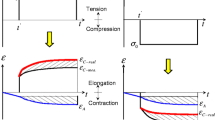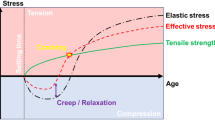Abstract
A novel model of mechanical performance of concrete at early ages and beyond, and in particular, evolution of its strength properties (aging) and deformations (shrinkage and creep strains), described in terms of effective stress is briefly presented. This model reproduces such␣ phenomena known from experiments like drying creep or some additional strains, as compared to pure shrinkage, which appear during autogenous deformations of a maturing, sealed concrete sample. Creep is described by means of the modified microprestress-solidification theory with some modifications to take into account the effects of temperature and relative humidity on concrete aging. Shrinkage strains are modelled by using effective stresses giving a good agreement with experimental data also for low values of relative humidity. Results of four numerical examples based on the real experimental tests are solved to validate the model. They demonstrate its possibilities to analyze both autogenous deformations in maturing concrete, and creep and shrinkage phenomena, including drying creep, in concrete elements of different age, sealed or drying, exposed to external load or without any load.
Résumé
Un nouveau modèle portant sur les performances mécaniques du béton aux jeunes âges et après, et notamment sur l’évolution de ses propriétés de résistance (vieillissement) et de ses déformations (contraintes de retrait et de fluage) décrites en termes de contraintes effectives, est brièvement présenté. Ce modèle reproduit ces phénomènes que l’on connaît grâce à des expériences telles que le fluage de séchage ou certaines contraintes supplémentaires, par comparaison avec le retrait pur, qui apparaît au cours des déformations endogènes d’un échantillon de béton verni arrivant à maturation. Le fluage est décrit à l’aide de la théorie de solidification du béton précontraint à l’échelle micro, théorie modifiée afin de prendre en compte les effets de la température et de l’humidité relative sur le vieillissement du béton. Les contraintes de retrait sont modélisées en utilisant des contraintes effectives, ce qui est également conforme aux données expérimentales pour de faibles taux d’humidité relative. Les résultats de quatre exemples numériques basés sur des essais expérimentaux réels sont donnés pour valider le modèle. Ils montrent les possibilités de ce modèle pour analyser à la fois les déformations endogènes lors de la maturation du béton, et les phénomènes de fluage et de retrait, y compris le fluage de séchage, dans des éléments en béton d’âges différents, vernis ou en phase de séchage, exposés à une charge externe ou bien sans aucune charge.
Similar content being viewed by others
References
Bazant ZP (ed) (1988) Mathematical modelling of creep and shrinkage of concrete. John Wiley & Sons Ltd, Chichester
Bazant ZP (2001) Prediction of concrete creep and shrinkage: past, present and future. Nucl Eng Des 203:27–38
Schrefler BA (2002) Mechanics and thermodynamics of saturated-unsaturated porous materials and quantitative solutions. Appl Mech Rev ASME 55(4): ␣351–388
Gawin D, Pesavento F, Schrefler BA (2002) Modelling of hygro-thermal behaviour and damage of concrete at temperature above critical point of water. Int J Numer Analyt Methods Geomechan 26(6):537–562
Gawin D, Pesavento F, Schrefler BA (2004) Modelling of deformations of high strength concrete at elevated temperatures. Mater Struct 37(268):218–236
Gawin D, Pesavento F, Schrefler BA, (2006a) Hygro-thermo-chemo-mechanical modelling of concrete at early ages. Part I: Hydration and hygro-thermal phenomena. Int J Numer Methods Eng 67(2): 299–331
Gawin D, Pesavento F, Schrefler BA (2006b) Hygro-thermo-chemo-mechanical modelling of concrete at early ages. Part II: Shrinkage and creep of concrete. Int J Numer Methods Eng 67(2): 332–363
Gray WG, Schrefler BA (2001) Thermodynamic approach to effective stress in partially saturated porous media. Eur J Mech A/Solids 20:521–538
Baroghel-Bouny V, Mainguy M, Lassabatere T, Coussy O (1999) Characterization and identification of equilibrium and transfer moisture properties for ordinary and high-performance cementitious materials. Cement Concrete Res 29:1225–1238
Lura P, Jensen OM, van Breugel K (2003) Autogenous shrinkage in high-performance cement paste: an evaluation of basic mechanisms. Modelling of autogenous relative humidity change and autogenous deformation. Cement Concrete Res 33:223–232
Bryant AH, Vadhanavikkit C (1987) Creep, shrinkage-size, and age at loading effects. ACI Mater J 84(2): 117–123
L’Hermite R, Mamillan M, Lefèvre C (1965) Nouveaux résultats de rechercher sur la déformation et la rupture du béton’ (in French). Supplément aux annales de l’Institute Technique du Bâtiment et des Travaux Publics 207/208:325–345
Russel HG, Corley WG (1997) Time-dependent behaviour of columns. In: ‘Water tower place’, research and development bulletin RD052.01B, Portland Cement Association
Bazant ZP (1972) Thermodynamics of interacting continua with surfaces and creep analysis of concrete structures. Nucl Eng Des 20:477–505
Skempton AW (1961) Effective stress in soils, concrete and rocks in‘Pore Pressure and Suction in Soils. Butherworths, London, pp 4–16
Bazant ZP, Prasannan S (1989) Solidification theory for concrete creep. I: Formulation. J Eng Mech ASCE 115:1691–1703
Bazant ZP, Hauggaard AB, Baweja S, Ulm FJ (1997) Microprestress-solidification theory for concrete creep. I: aging and drying effects. J Eng Mech ASCE 123(11):1188–1194
De Schutter G, Taerwe L (1996) Degree of hydration-based description of mechanical properties of early age concrete. Mater Struct 29:335–344
Bazant ZP, Hauggaard AB, Baweja S (1997) Microprestress-solidification theory for concrete creep. II: algorithm and verification. Journal of J Eng Mech ASCE 123(11):1195–1201
Acknowledgements
This work has been carried out in the framework of the UE project “MAECENAS” (“Modelling of Ageing in Concrete Nuclear Power Plant Structures”), Nr. FIKS-CT-2001-00186. The first author was partially funded by CISM (International Center for Mechanical Sciences), Udine–Italy. The authors are grateful to MSc M. Wyrzykowski for his help in part of the numerical computations.
Author information
Authors and Affiliations
Corresponding author
Rights and permissions
About this article
Cite this article
Gawin, D., Pesavento, F. & Schrefler, B. Modelling creep and shrinkage of concrete by means of effective stresses. Mater Struct 40, 579–591 (2007). https://doi.org/10.1617/s11527-006-9165-1
Received:
Accepted:
Published:
Issue Date:
DOI: https://doi.org/10.1617/s11527-006-9165-1




